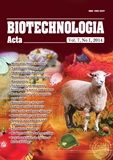ISSN 2410-7751 (Print)
ISSN 2410-776X (Online)

"Biotechnologia Acta" v. 7, no 1, 2014
https://doi.org/10.15407/biotech7.01.110
Р. 110-116, Bibliography 17, Ukrainian
Universal Decimal classification: 579.222: 547.979.8
SEARCH PRODUCERS OF POLYPHENOLS AND SOME PIGMENTS AMONG BASIDIOMYCETES
Fedotov О. V., Veligodska A. K.
Donetsk National University, Ukraine
General content of polyphenols, carotenoids and melanin in basidiomycetes carpophorus was determined. 50 species were studied, 27 of which belong to the Polyporales form and 23 are to the Agaricales form. In order to determine the total content of phenolic substances spectrophotometric methods were used. Polyphenols were studied in alcoholic extracts through the modified Folin-Chokalteu procedure; melanin — by alkaline hydrolysis and calculated using a calibration curve (by pyrocatechol), carotenoids were studied in acetone extracts and calculated by the Vetshteyn formula. Statistical and cluster analysis of the data enabled to identify species of basidiomycetes that are perspective for biotechnology. The most promising in terms of total polyphenols, carotenoids and melanins of poliporal basidiomycetes are species Fomes fomentarius, Ganoderma applanatum, Ganoderma lucidum and Laetiporus sulphureus, and among agarikal fungi — Fistulina hepatica, Flammulina velutipes, Pleurotus ostreatus, Stropharia rugosoannulata, Agrocybe cylindracea and Tricholoma flavovirens. These species of Basidiomycetes were isolated in pure mycelia culture to find out their biosynthetic activity.
Key words: basidiomycetes, carpophores, polyphenols, carotenoids, melanins.
© Palladin Institute of Biochemistry of National Academy of Sciences of Ukraine, 2014
References
1. Bukhalo A. S., Babickaya V. G., Bisko N. A., Wasser S. P., Dudka I. A. Biological properties of the drug culture in macromycetes. Kyiv: Alterpres. 2011, 212 p. (In Russian).
2. Asatiani M. D., Elisashvili G., Songulashvili A. Z. Reznik V. I., Wasser S. P. Higher basidiomycetes mushrooms as a source of antioxidants. Progr. Mycol. 2010, P. 311–327.
3. Fedotov O. V. Antioxidizing activity of mycelium of mushroom stocks Pleurotus (Fr.) Kumm. and Flammulina (Curt.: Fr.) Sing. Int. J. Med. Mush. 2001, 3(2–3), Р. 143.
4. Halvorsen B. L., Holte K. Myhrstad M. C. W. A systematic screening of Total Antioxidants in dietary plants. J. Nutr. 2002, V. 132, P. 461–471.
5. Bekker Z. E. Physiology and Biochemistry of fungi. — M.: Izdat. Moskovskogo Univer. 1988, 230 p. (In Russian).
6. Sysoeva M. A., Kuznetsova O. V., Gamayurova V. S. Structural organization and properties of fungus polyphenols. Vestnik Kazan. Technolog. Universit. 2005, N 1, P. 244–250. (In Russian).
7. Nikitinа V. S., Kuzmin L. Y., Melentev A. L., Schendel G. V. Antibacterial activity of polyphenolic compounds isolated from plants of the families Geranieceae and Rosaceae. Prikl. Biochem. Microbiol. 2007, 6(43), 705–712. (In Russian).
8. Gessler N. N., Sokolov A. B., Belozerskaya T. The participation of b-carotene in antioxidant protection of fungal cells. Prikl. Biochem. Microbiol. 2003, 4(39), 427–429. (In Russian).
9. Ribeiro B., de Pinho G., Andrad P. B., Oliveira C., Ferreira A. C. S., Baptista P., Valentao P. Do Bioactive Carotenoids Contribute to the Color of Edible Mushrooms? The Open Chem. Biomed. Meth. J. 2011, N 4. P. 14–18.
10. Babitskaya V. G., Shcherba V. V. The Nature of Melanin Pigments of Several Micro- and Macromycetes. Appl. Biochem. Microbiol. 2002, V. 38, Iss. 3, P. 247–251.
https://doi.org/10.1023/A:1015471324658
11. Zhdanova N. N., Vasilevska A. I. Extreme ecology of fungi in nature and experiment. Kyiv: Nauk. Dumka. 1982, 168 p. (In Russian)
12. Wasser S. P. Medicinal mushroom Science: History, Current Status, Future Trends, and Unsolved problems. Int. J. Med. Mush. 2010, 12(1), 1–16.
https://doi.org/10.1615/IntJMedMushr.v12.i1.10
13. Kirk P. M., Cannon P. F., David J. C., Stalpers J. A. Ainsworth & Bisby’s Dictionary of the fungi, 9th ed. Wallingford: CAB International. 2001, 655 р.
14. Vetchinkina E. P., Nikitina V. E., Babickaya V. G., Scherba V. V., Puchcova T. A., Smirnova D. A., Osadchaya O. V. Dynamics of glycoproteins and high phenols mushroom Lentinus edodes in submerged culture. Samarskaya Luka. 2008, 17(2) (24), P. 367–372. (In Russian).
15. Musienko M. M., Parshikova T. P., Slavnyi P. S. Spectrophotometric methods in practice, physiology, biochemistry and ecology of plants. Kyiv: Phytosociocentr. 2001, 200 p. (In Russian).
16. Prisedsky J. G. The software package for statistical analysis of the results ofbiological experiments. Donetsk: Kasiopeya. 1999, 210 p. (In Russian).
17. Lakin G. F. Biometry. Moskva: Visshaya Shkola. 1990, 352 p. (In Russian).

